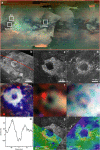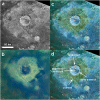Spectral properties of Titan's impact craters imply chemical weathering of its surface
- PMID: 27656006
- PMCID: PMC5012121
- DOI: 10.1002/2015GL063824
Spectral properties of Titan's impact craters imply chemical weathering of its surface
Abstract
We examined the spectral properties of a selection of Titan's impact craters that represent a range of degradation states. The most degraded craters have rims and ejecta blankets with spectral characteristics that suggest that they are more enriched in water ice than the rims and ejecta blankets of the freshest craters on Titan. The progression is consistent with the chemical weathering of Titan's surface. We propose an evolutionary sequence such that Titan's craters expose an intimate mixture of water ice and organic materials, and chemical weathering by methane rainfall removes the soluble organic materials, leaving the insoluble organics and water ice behind. These observations support the idea that fluvial processes are active in Titan's equatorial regions.
Keywords: Titan; erosion and weathering; impact cratering.
Figures



References
-
- Aharonson, O. , Hayes A. G., Lopes R., Lucas A., Hayne P., and Perron J. T. (2014), Titan's surface geology, in Titan: Surface, Atmosphere and Magnetosphere, edited by Mueller‐Wodarg I. et al., pp. 43–75, Cambridge Univ. Press, Cambridge, U. K.
-
- Artemieva, N. , and Lunine J. I. (2005), Impact cratering on Titan II. Global melt, escaping ejecta, and aqueous alteration of surface organics, Icarus, 175, 522–533, doi:10.1016/j.icarus.2004.12.005. - DOI
-
- Barlow, N. G. , Boyce J. M., Costard F. M., Craddock R. A., Garvin J. B., Sakimoto S. E., Kuzmin R. O., Roddy D. J., and Soderblom L. A. (2000), Standardizing the nomenclature of Martian impact crater ejecta morphologies, J. Geophys. Res., 105, 26,733–26,738, doi:10.1029/2000JE001258. - DOI
-
- Barnes, J. W. , Brown R. H., Soderblom L., Buratti B. J., Sotin C., Rodriguez S., Le Mouélic S., Baines K. H., Clark R., and Nicholson P. (2007a), Global‐scale surface spectral variations on Titan seen from Cassini/VIMS, Icarus, 186, 242–258, doi:10.1016/j.icarus.2006.08.021. - DOI
-
- Barnes, J. W. , et al. (2007b), Near‐infrared spectral mapping of Titan's mountains and channels, J. Geophys. Res., 112, E11006, doi:10.1029/2007JE002932. - DOI
LinkOut - more resources
Full Text Sources
